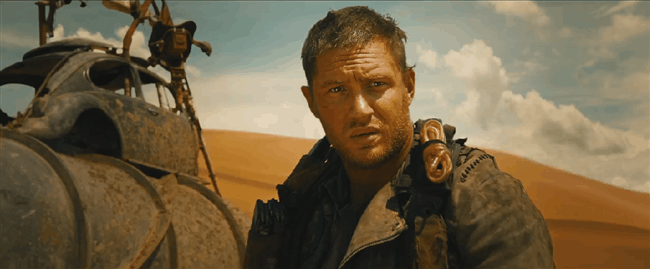High Gear
“Mad Max: Fury Road.”
BY ANTHONY LANE

There is a moment, in “Mad Max: Fury Road,” when Max (Tom Hardy) washes blood off his face. This is unsurprising, since he has just engaged in one of many fights, but two points are worthy of note. First, the blood is not his. Second, he washes it off not with water but with mother’s milk, siphoned from a gas tanker. And there, in one image, you have George Miller’s film—wild and unrelenting, but also possessed of the outlandish poetry, laced with hints of humor, that rises to the surface when the world is all churned up.
The movie is set in the near future. There are no cities or civilizations left. The landscape is dying of thirst; water—known as Aqua Cola—is severely rationed; and other resources, notably gasoline, are hoarded and tussled over like scraps of food. Max is a survivor, like everyone else, and, as we join the stream of action, he is captured and hauled into servitude at the Citadel. Girded with towers of rock, this is the desert stronghold of Immortan Joe (Hugh Keays-Byrne), a monstrous figure who lords it over a swarm of ragged wretches. His toadlike skin is caged in a transparent breastplate, and he breathes through a mask that’s armed with yellowing horses’ teeth and fed by bellows that wheeze up and down on the back of his neck. Probably a charming fellow, once you get to know him.

Max, being Max, tries to escape, only to be grabbed once more and strapped to the front of a vehicle, like a fender of flesh, with his sturdy features barred by a metal grille. Tom Hardy fans, who struggled so intently to understand him when he played Bane, in “The Dark Knight Rises,” may be less than thrilled to learn that their hero’s speech is yet again impeded. Just as you’re wondering if the poor guy will ever express himself freely, however, Imperator Furiosa (Charlize Theron), a new acquaintance of Max’s, asks, “You want that thing off your face?” The day is saved, though it’s not as if he starts chatting away like Cary Grant in “His Girl Friday.” You could tattoo the entirety of Max’s dialogue onto his biceps. One of his longest lines is “Hope is a mistake.”
Furiosa has a prosthetic arm, and her tendency to smear black grease across her brow may cause the fragrance honchos at Dior, where Theron is paid to spread the word about J’Adore, to reach for their atomizers. Furiosa is a driver, employed by Joe’s henchmen to transport precious fuel, who suddenly goes rogue, steering the War Rig, her vast and snarling truck, off course. A posse is dispatched to hunt her down. We soon discover her concealed cargo—the Wives, five young women who were imprisoned by Immortan Joe and doomed to bear his children. Our first glimpse of them bodes ill: limber beauties, draped in muslin underwear and hosing themselves down in the middle of nowhere. It’s like the start of a Playboy shoot. Yet the film not only recovers but winds up as a testament to female resilience, thanks to the Vuvalini—a small and leathery tribe of matriarchs, described by the film’s production designer as “lovely old bikie chicks.” Astride belching motorcycles, they hare up and down sand dunes, and accompany Max, Furiosa, and the Wives on the final leg of the plot.
I have been looking forward to this movie for months, trying not to watch the trailers more than twice a day, but, fool that I am, I hadn’t foreseen its feminist ambitions—crystallized in the sight of one Wife, heavily pregnant, flinging wide the door of the War Rig and flaunting her belly, like a bronze shield, at her enraged pursuers. (The Wives were coached in preparation for the film by Eve Ensler, the author of “The Vagina Monologues.” This must be a first. Gloria Steinem was never hired as a consultant on “The Dirty Dozen.”) Later comes a droll sequence with a sniper’s rifle, as our hero aims at a searchlight, in the distant gloom, but misses. Only one bullet remains. Furiosa takes the gun and hits the target, using Max’s shoulder as a rest. The tough guy is nothing but a cushion.
The good news is that “Mad Max: Fury Road” exists in a different league. It lies way, way beyond Thunderdome, and marks one of the few occasions on which a late sequel outdoes what came before. Is it a sequel, though? There are flashbacks to Max’s past, but they are over in seconds, and you can certainly relish the new film, in all its lunatic majesty, without being versed in Maxist dialectics. Indeed, it exults in a proud indifference to backstory. Furiosa mentions her origins, explaining that she was snatched away from “a green place,” but that’s it. As for Max, Hardy is more earthed than Gibson, and less wired—indeed, less mad, propelled not by the engine of wrath but by a solid response to the madness that engulfs the characters like a sandstorm. Max’s deeds rarely strike us as gratuitous. Instead, they seem resignedly brutal, as if there were no other way to live. Whether his deepest desire is for liberty, or simply for a dour solitude, I can’t decide, but I loved the coolness with which, having taken command in battle, he melts away, once it’s over, into the shifting throng.
READ MORE HERE: http://www.newyorker.com/magazine/2015/05/25/high-gear-current-cinema-anthony-lane

No comments:
Post a Comment